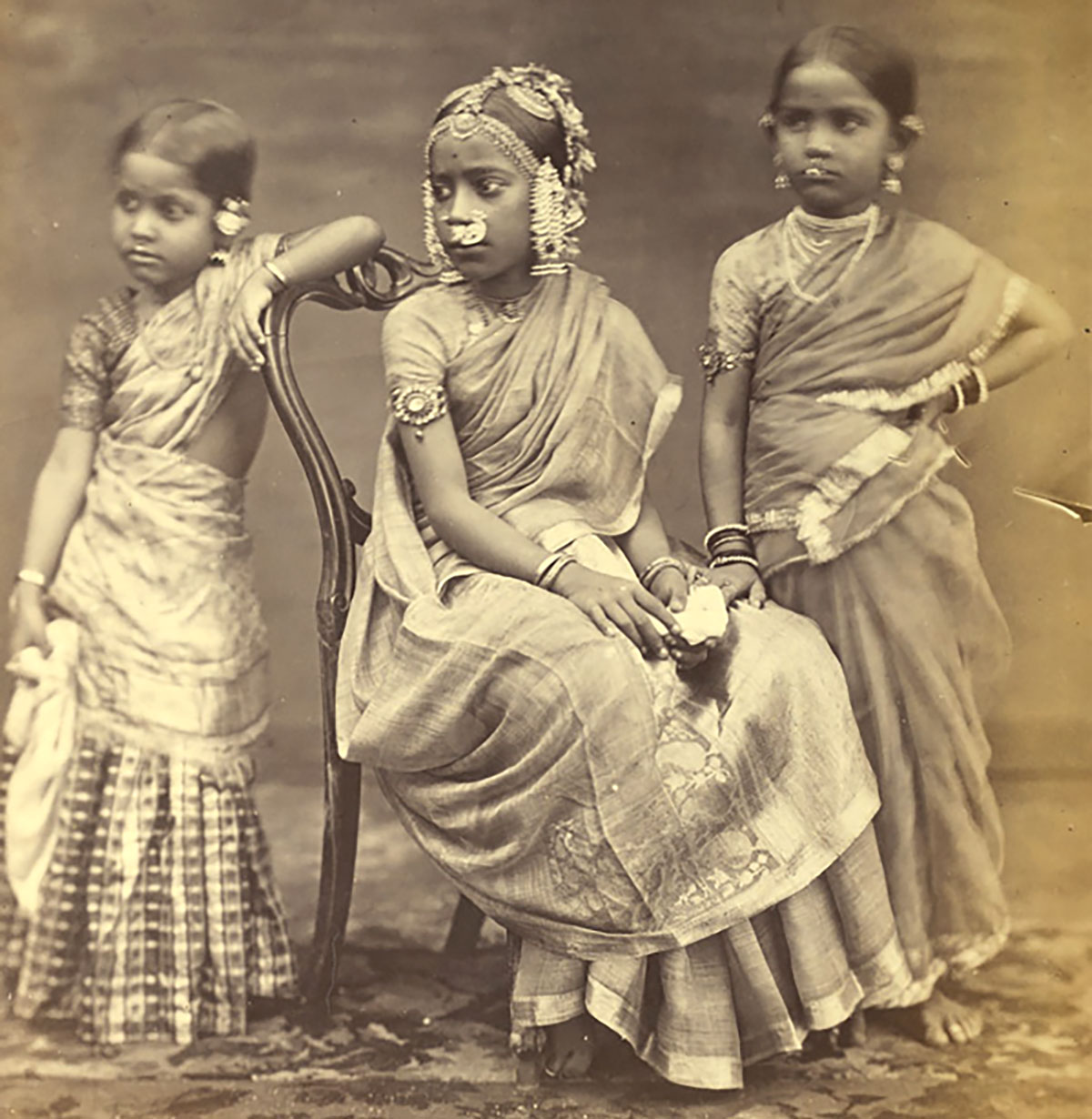ARTICLE
Half Sari
A traditional dress worn by adolescent girls, the half sari is a garment consisting of three parts — a skirt, a blouse and a cloth to be draped over the upper body. Mostly popular in South India, the garment is known by different names in each state, including langa voni in Andhra Pradesh, pavada davani in Tamil Nadu and langa davani in Karnataka. The garment is closely associated with coming of age rituals and, traditionally, a girl was gifted a half sari by her maternal grandparents to mark her entry into womanhood.
The lower skirt-like garment, called the langa or pavada, is an ankle length skirt gathered around the waist and held in place by a string. The upper garment is a blouse, similar to the one worn with a full-length sari. The voni, or the davani, is a 2 to 2.5 m long piece of fabric that is tucked into the waist at one end, wrapped around back of the body and draped diagonally across the front, with the remaining fabric hung over the right shoulder in a manner similar to the pallu of a sari. The draping of the voni over the shoulder distinguishes the half sari from its North Indian counterpart, the lehenga choli (also known as ghagra choli or chaniya choli), where the voni – or in this case the dupatta or odhni – is worn draped over the head, with the other end tucked into the waist.
Typically, unmarried women wear half saris, while married women wear full-length saris. The half-sari closely resembles the pattu pavada, or the silk pavada, worn by younger girls. The latter, however, does not include a voni and consists of a blouse that reaches the waist, covering the midriff unlike the blouse of a half sari. Similar to the full length sari, the half sari is available in numerous fabrics, colours and designs.
Bibliography
Our website is currently undergoing maintenance and re-design, due to which we have had to take down some of our bibliographies. While these will be re-published shortly, you can request references for specific articles by writing to hellomapacademy@map-india.org.






![The façade of the Maneckji Seth Agiary, a Zoroastrian fire temple, is a standout example of the popularity of the Persian Revival Style in Western India in the 19th and 20th centuries. This style was often seen in the architectural patronage of the Parsis, who emerged as one of the most influential mercantile communities of British India. Popular motifs of this style, like the mythical lamasus (winged bulls with human heads) and the faravahar (a winged guardian spirit in Zoroastrianism), drew on the historical art and architecture of the Achaemenid and Sasanian empires from sites like Persepolis, Bisotun, Taq-e Bostan, Naqsh-e Rostam and Naqsh-e Rajab in Persia.
The Parsi community’s adoption of this style occurred largely due to their networks of global commerce and politics, allowing them to access and translate research of ancient Persia into visible symbols that underlined their association with antiquity, imperial power, and art.
نمای آتشکدهی زرتشتی مانِکجی سِت نمونهی بارزی از رواج سبک «احیای [معماری] ایرانی» در غرب هند طی سدههای نوزدهم و بیستم است. این سبک غالباً در بناهایی دیده میشد که پارسیان، از بانفوذترین جوامع بازرگان در هند بریتانیا، بانیشان بودند. نقشمایههای محبوب این سبک، مانند گاو بالدار اساطیری (لاماسو) و فَروَهَر (روح بالدار نگهبان در دین زرتشت)، برگرفته از هنر و معماری شاهنشاهی هخامنشی و ساسانی، در جاهایی چون تخت جمشید و بیستون و طاق بستان و نقش رستم و نقش رجب، بود.
اقتباس جامعهی پارسیان از این سبک بسیار مرهون روابط گستردهی تجاری و سیاسی آنها بود که دسترس به پژوهشها دربارهی ایران باستان و برگردانیدن آنها به نمادهای بصری را ممکن میکرد و بر پیوند پارسیان با دوران باستان و قدرت شاهنشاهی و هنر تأکید میکرد.](https://mapacademy.io/wp-content/plugins/instagram-feed/img/placeholder.png)
